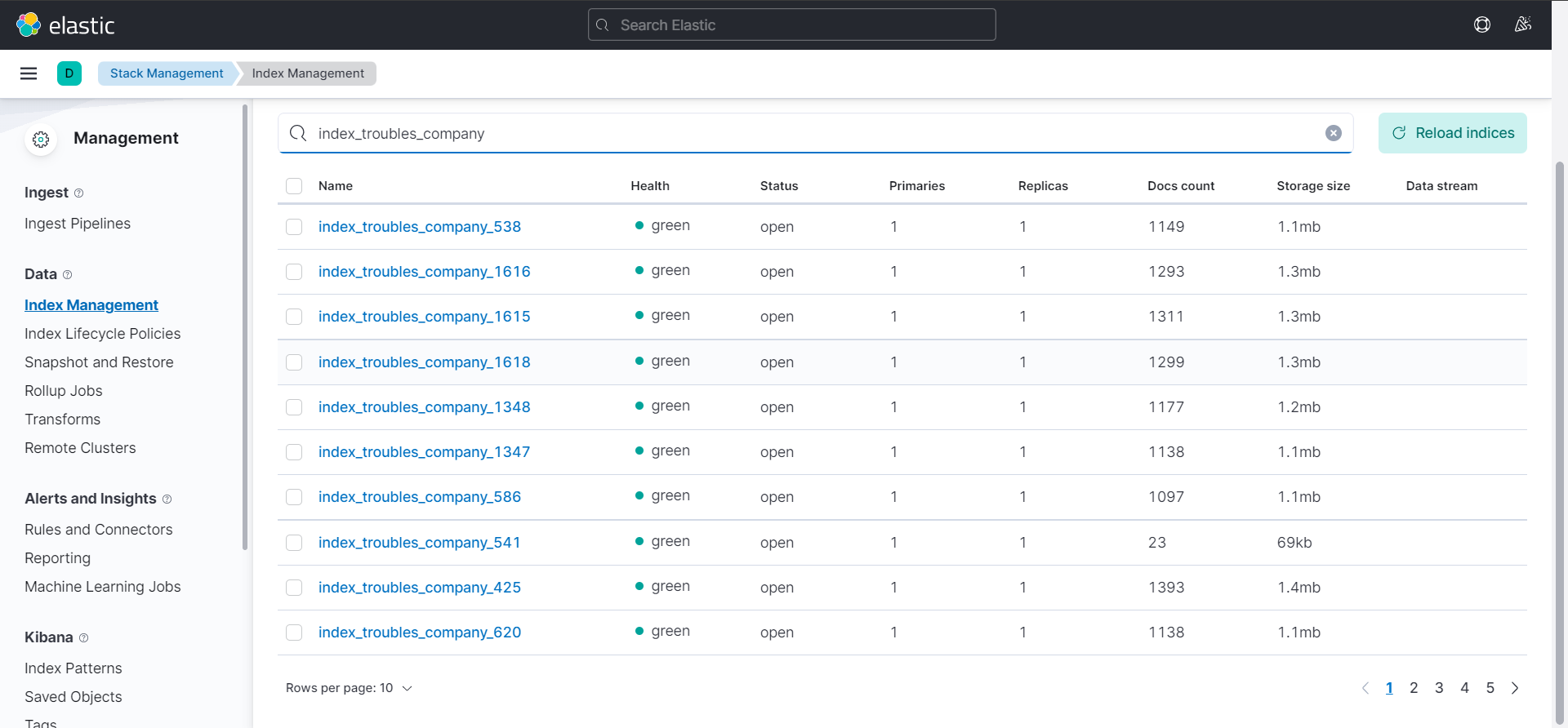查找了很多方法都是通过Spring EL表达式实现 @Document(IndexName="#{demo.getIndexName}")
这种方式的问题在于没法解决数据库里生成的序号,例如我希望通过公司ID生成索引编号。后来在外网上找到一个大佬提出的解决方案,这位大佬把两种方案都实现了一遍。
通过entityId自定义index
Use an index name defined by the entity to store data in Spring Data Elasticsearch 4.0
通过SpEL动态生成index
How to provide a dynamic index name in Spring Data Elasticsearch using SpEL
我这里按照entity的方式实现了需求
elasticsearch 版本7.17.3
springboot版本2.7.1
Bean
@Data
@Builder
@AllArgsConstructor
@NoArgsConstructor
@EqualsAndHashCode(callSuper = false)
@Document(indexName = ElasticSearchIndices.ES_INDEX_TROUBLES_COMPANY+"_*",createIndex = false)
public class CompanyTroubleshootingBean implements Serializable {
private static final long serialVersionUID = 1L;
@Id
@JsonFormat(shape = JsonFormat.Shape.STRING)
@JsonSerialize(
using = ToStringSerializer.class
)
@Field(type = FieldType.Keyword , store = true)
private Long id;
@Field(type = FieldType.Text, analyzer = "ik_smart")
private String content;
@Field(type = FieldType.Text, analyzer = "ik_smart")
private String searchKeyword;
@Field(type = FieldType.Text, analyzer = "ik_max_word", searchAnalyzer = "ik_smart")
private String contentMaxWord;
@Field(type = FieldType.Text, analyzer = "ik_max_word", searchAnalyzer = "ik_smart")
private String searchKeywordMaxWord;
private Integer useCounts;
//也是内容 这个内容不能分词查询
@Field(type = FieldType.Keyword)
private String keywordContent;
@Field(type = FieldType.Keyword)
private Integer catalogId;
public String getContentMaxWord() {
return content;
}
//私有化set方法,让该属性只读
private void setContentMaxWord(String contentMaxWord) {
this.content = contentMaxWord;
}
public String getSearchKeywordMaxWord() {
return searchKeyword;
}
//私有化set方法,让该属性只读
private void setSearchKeywordMaxWord(String searchKeywordMaxWord) {
this.searchKeyword = searchKeywordMaxWord;
}
/**
* 公司ID
*/
private Integer companyId;
/**
* 平台的解决方案ID
*/
@JsonFormat(shape = JsonFormat.Shape.STRING)
@JsonSerialize(
using = ToStringSerializer.class
)
private Long platformTroubleshootingId;
}
接口
//相当于重新定义了一个repository
public interface CompanyTroubleshootElasticRepository<T> {
<S extends T> S save(S entity);
<S extends T> Iterable<S> save(Iterable<S> entities);
}实现类
package online.ejiang.service.impl.troubleshooting;
import lombok.RequiredArgsConstructor;
import lombok.extern.slf4j.Slf4j;
import online.ejiang.enums.ElasticSearchIndices;
import online.ejiang.pojo.elasticsearch.CompanyTroubleshootingBean;
import org.springframework.data.elasticsearch.core.ElasticsearchOperations;
import org.springframework.data.elasticsearch.core.IndexOperations;
import org.springframework.data.elasticsearch.core.document.Document;
import org.springframework.data.elasticsearch.core.mapping.IndexCoordinates;
import org.springframework.lang.NonNull;
import org.springframework.lang.Nullable;
import org.springframework.stereotype.Service;
import java.util.concurrent.ConcurrentHashMap;
/**
* <p>
* 公司故障排除及定价 服务实现类
*
* </p>clo
*
* @author Phil
* @since 2020-07-22
*/
@Service
@Slf4j
@RequiredArgsConstructor
public class CompanyTroubleshootingRepositoryImpl implements CompanyTroubleshootElasticRepository<CompanyTroubleshootingBean> {
private final ElasticsearchOperations operations;
@Nullable
private Document mapping;
@Override
public <S extends CompanyTroubleshootingBean> S save(S entity) {
IndexCoordinates indexCoordinates = getIndexCoordinates(entity);
S saved = operations.save(entity, indexCoordinates);
operations.indexOps(indexCoordinates).refresh();
return saved;
}
@Override
public <S extends CompanyTroubleshootingBean> Iterable<S> save(Iterable<S> entities) {
if (entities != null && entities.iterator().hasNext()) {
IndexCoordinates indexCoordinates = getIndexCoordinates(entities.iterator().next());
Iterable<S> saved = operations.save(entities, indexCoordinates);
operations.indexOps(indexCoordinates).refresh();
return saved;
}
return null;
}
@NonNull
private <S extends CompanyTroubleshootingBean> IndexCoordinates getIndexCoordinates(S entity) {
String indexName = ElasticSearchIndices.ES_INDEX_TROUBLES_COMPANY + "_" + entity.getCompanyId();
//把单实例的Map变成每次调用都初始化,解决重新同步时需要重启服务器的问题。
ConcurrentHashMap<String, IndexCoordinates> knownIndexCoordinates = new ConcurrentHashMap<>();
return knownIndexCoordinates.computeIfAbsent(indexName, i -> {
IndexCoordinates indexCoordinates = IndexCoordinates.of(i);
IndexOperations indexOps = operations.indexOps(indexCoordinates);
if (!indexOps.exists()) {
indexOps.create();
if (mapping == null) {
mapping = indexOps.createMapping(CompanyTroubleshootingBean.class);
}
indexOps.putMapping(mapping);
}
return indexCoordinates;
});
}
}
调用
do {
IPage<CompanyTroubleshootingBean> beanPage = this.pageByCustom(new MyPage<>(index, 800), companyId);
pages = beanPage.getPages();
Iterable<CompanyTroubleshootingBean> saved = companyTroubleshootElasticRepository.save(beanPage.getRecords());
if (saved != null && saved.iterator().hasNext()) {
index++;
} else {
break;
}
} while (index <= pages);




















 3201
3201











 被折叠的 条评论
为什么被折叠?
被折叠的 条评论
为什么被折叠?








